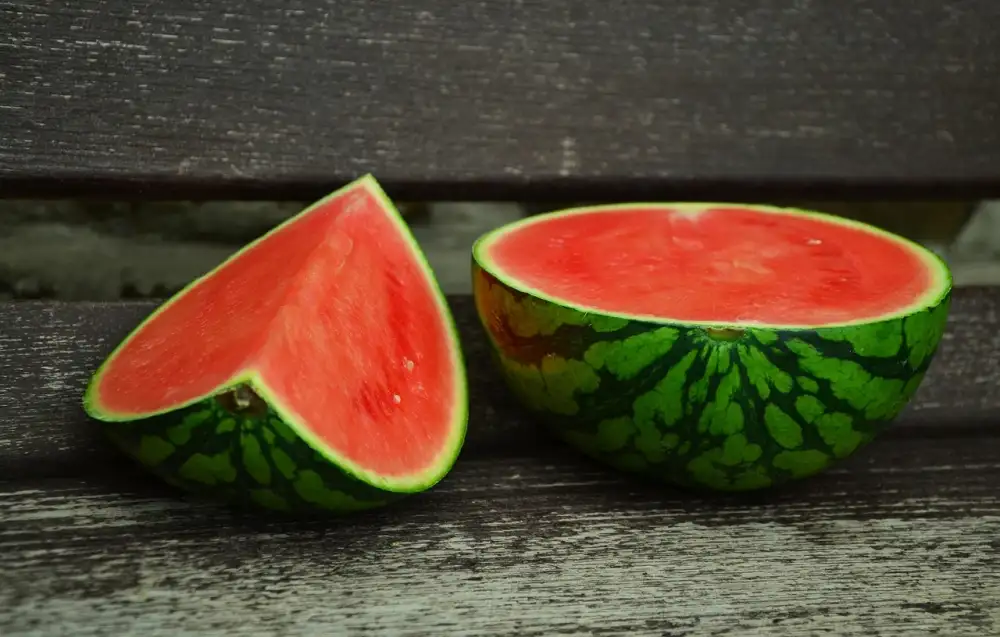Unlock the Secrets: How to Determine if Your Watermelon is Ripe

- Look for a yellow spot on the watermelon's skin.
- Tap the watermelon and listen for a deep, hollow sound.
- Check the weight of the watermelon - it should feel heavy for its size.
- Examine the skin for a dull, matte appearance.
- Press the watermelon's rind - it should give slightly under gentle pressure.
- Smell the bottom of the watermelon for a sweet, fruity aroma.
- Cut a small slice and observe the color and texture of the flesh.
- Taste a small piece to confirm the sweetness and juiciness.
- Consider the season and local availability for a better chance of finding a ripe watermelon.
Look for a yellow spot on the watermelon's skin.
When determining if a watermelon is ripe, one of the first things to look for is a yellow spot on its skin. This spot indicates that the watermelon has been sitting on the ground and ripening in the sun. The larger and darker the spot, the longer it has had to ripen. So, be sure to inspect the skin closely for this yellow patch before making your selection.
Tap the watermelon and listen for a deep, hollow sound.
One way to determine if a watermelon is ripe is by tapping it and listening for a deep, hollow sound. Gently tap the watermelon with your knuckles or the palm of your hand. If you hear a dull thud, it may indicate that the fruit is underripe. However, if you hear a deep, hollow sound, it suggests that the watermelon is ripe and full of juice. This tapping method works because as a watermelon ripens, the flesh becomes softer and more watery, resulting in a hollower sound when tapped. So remember, listen for that satisfying deep sound when you tap your watermelon to ensure its ripeness.
Check the weight of the watermelon - it should feel heavy for its size.
When determining if a watermelon is ripe, one important factor to consider is its weight. A ripe watermelon should feel heavy for its size. This is because as the fruit ripens, it accumulates more water content, making it denser and heavier. When you pick up a watermelon, compare its weight to other watermelons of similar size. If it feels lighter than expected, it may indicate that the fruit is not fully ripe. On the other hand, if the watermelon feels significantly heavier than others of the same size, it could be overripe or have a higher sugar content. So remember, when selecting a watermelon, go for one that feels substantial and heavy in your hands.
Examine the skin for a dull, matte appearance.
When determining if a watermelon is ripe, it's important to examine the skin. A ripe watermelon will have a dull, matte appearance rather than a shiny or glossy one. This is because as the fruit ripens, the skin loses its sheen and becomes less vibrant. So, when you're at the market or grocery store, be sure to look for a watermelon with a dull skin to ensure that it's ready to be enjoyed.
Press the watermelon's rind - it should give slightly under gentle pressure.
Pressing the watermelon's rind is another useful technique to determine its ripeness. Apply gentle pressure with your thumb or finger and see if it gives slightly. A ripe watermelon will have a slight give, indicating that it is soft and juicy inside. If the rind feels firm or hard, it may be underripe. Avoid pressing too hard as this can damage the fruit. Remember, a little give is a good sign of a perfectly ripe watermelon!
Smell the bottom of the watermelon for a sweet, fruity aroma.
Smelling the bottom of a watermelon can provide valuable clues about its ripeness. A ripe watermelon will emit a sweet, fruity aroma from its base. Take a moment to inhale deeply and see if you can detect this enticing scent. If the watermelon lacks any fragrance or has an unpleasant odor, it is likely not yet ripe. The aroma is a strong indicator of the fruit's flavor and juiciness, so trust your nose when determining if your watermelon is ready to be enjoyed.
Cut a small slice and observe the color and texture of the flesh.
Cutting a small slice of the watermelon is a foolproof way to determine its ripeness. Look for a vibrant, deep red color in the flesh. Avoid watermelons with pale or white flesh as they are likely underripe. The texture should be firm but not too hard, with a slight crispness to it. If the flesh appears mushy or grainy, it is a sign of overripeness. A ripe watermelon will have a juicy and succulent texture that is easy to bite into. Remember, the color and texture of the flesh are key indicators of its ripeness, so take your time to examine it closely before making your final decision.
Taste a small piece to confirm the sweetness and juiciness.
Tasting a small piece of the watermelon is the ultimate test to confirm its sweetness and juiciness. Once you have followed all the previous steps to determine if the watermelon is ripe, it's time to indulge your taste buds. Take a small slice and savor it slowly. A ripe watermelon should be bursting with sweet, refreshing flavors and have a juicy texture that leaves you craving for more. If the taste falls flat or lacks sweetness, it may indicate that the watermelon is not fully ripe. Trust your taste buds to make the final judgment on the quality of your chosen fruit.
Consider the season and local availability for a better chance of finding a ripe watermelon.
Consider the season and local availability for a better chance of finding a ripe watermelon. Watermelons are typically in season during the summer months, from June to August. During this time, you are more likely to find a wide variety of ripe and delicious watermelons at your local grocery store or farmer's market. Additionally, purchasing watermelons that are locally grown can increase your chances of finding a ripe one, as they are more likely to be harvested at the peak of ripeness. So, before you head out to buy a watermelon, do a little research on the best time to buy them in your area for the juiciest and sweetest results.
Published: 05. 12. 2023
Category: Food



